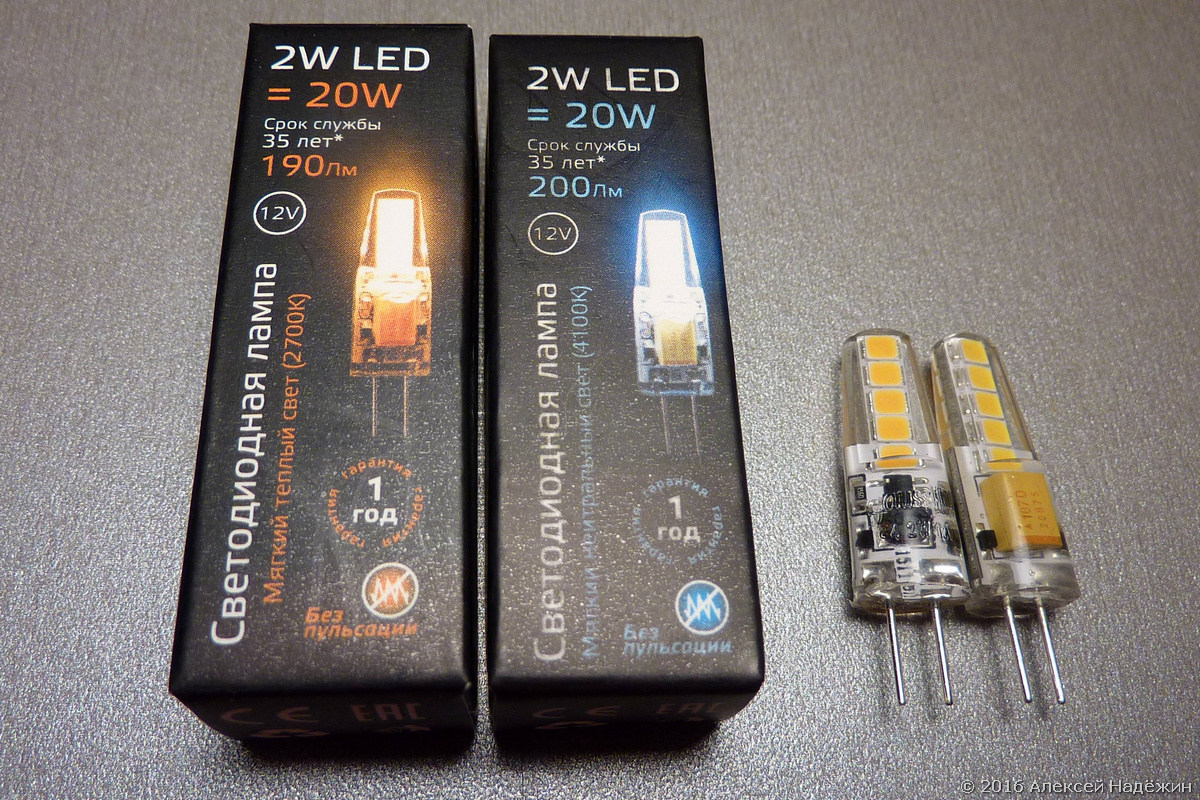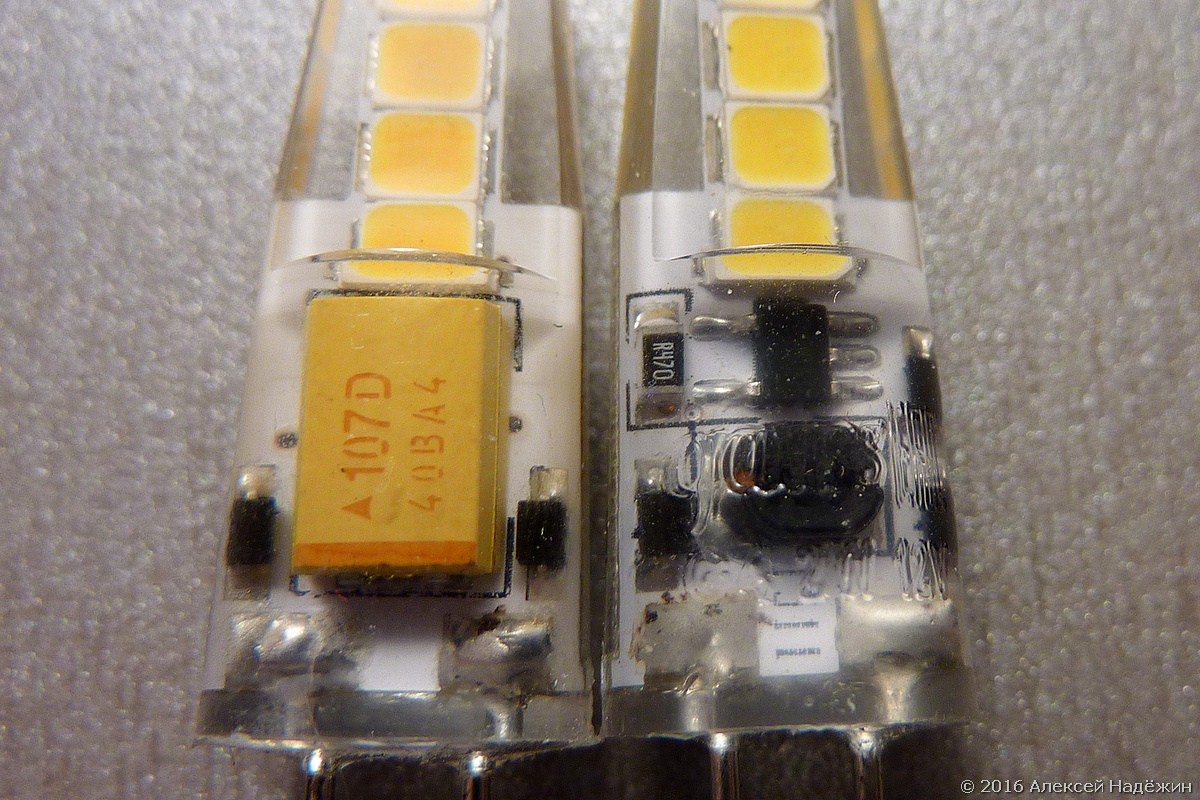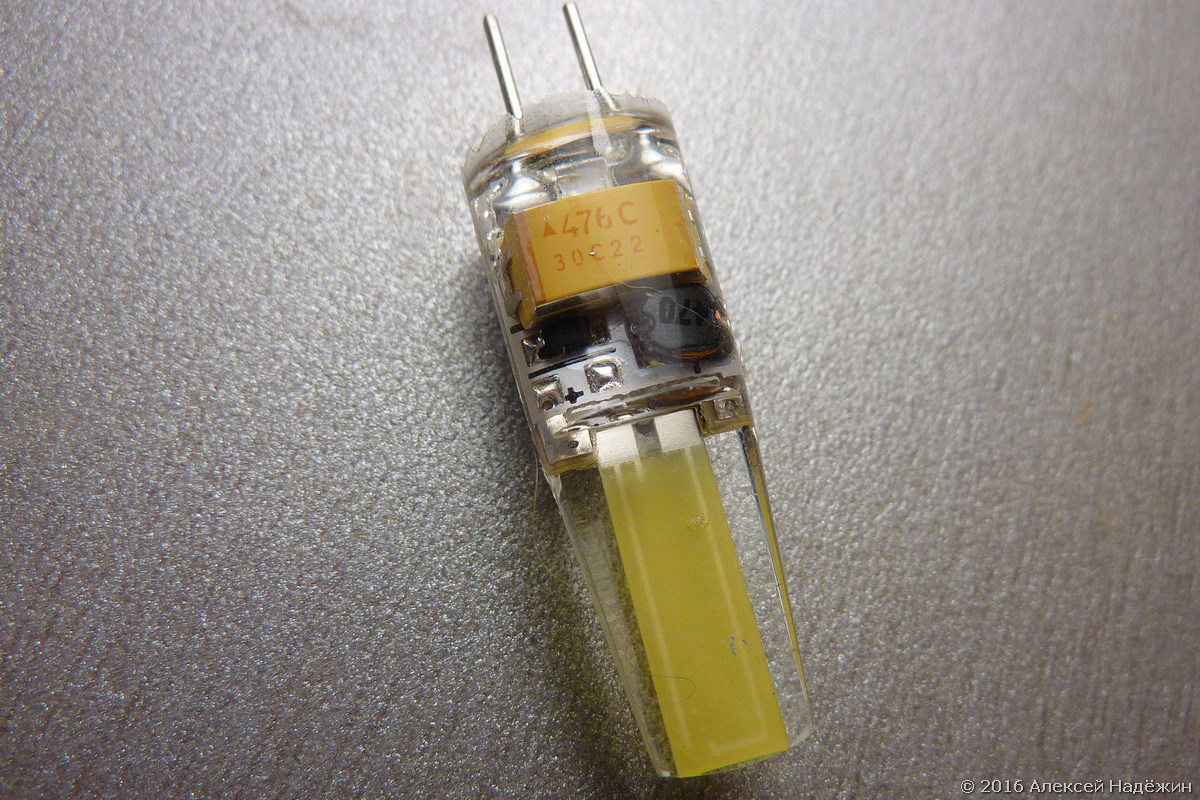G4 Pulsation LED Bulbs
I continue to rake the rubble of light bulbs. Over the past week I tested more than 75 pieces. It remains to enter data on the site.
Among the tested lamps, I got two microlamps of the G4 format, which surprised me.

')
I was sure that it was impossible to make such small lamps not have a pulsation of light when powered by alternating voltage and the only way to avoid pulsation is to power 12-volt lamps from a constant voltage source. It turned out that making lamps without pulsation in such a format is still possible. The pulsation of light of these lamps does not exceed one and a half percent.
In order to smooth the ripple, you need a large capacitor. At first glance, he is not here.

On one side of the board there is a coil in the center, a 5-pin microcircuit, a resistor and three diode-like parts. On the other hand, two more similar details and a large yellow rectangle with the inscription 107D. This is the capacitor, but not the usual cylindrical electrolytic, and tantalum. 100 μF, 20 V.

In Chinese bulbs of this type with an unacceptable ripple of 60% (such lamps are better powered from constant voltage to avoid light pulsation), a similar capacitor also exists, but it says 476C - 47 microfarad, 16V. For a two-watt lamp, such a capacity is not enough.

The first two digits in the marking are multiplied by a factor, which is encoded by the third digit (6 - 1 μF, 7 - 10 μF), the letter indicates the operating voltage (A - 10 V, C - 16 V, D - 20 V).
Knowing this information, it is possible to determine whether the lamp will have a ripple of a similar construction according to what is written on the capacitor. For 1.5-2 W of real power (3 W can be written on the package), you need at least 100 µF.
ps Lamp without pulsation on the title photo - Gauss. They surprised me by the fact that with a high measured CRI they have an unpleasant greenish light. I will write about this separately.
pps Having spent most of the past week testing (and adding data to the site is still to be this week), I realized that I could not do without outside help. In this regard, for the development of the project lamptest.ru I am looking for:
1. A person working in the center of Moscow next to the metro, who will be able to accept light bulbs for testing, accumulate them at home and give them to me once every couple weeks (I am ready to come after them), and then take them from me (I will come again ) and distribute back.
2. Assistants on a voluntary basis, ready to do one or more things:
- photographing lamps;
- entering data on the lamps into the database before testing;
- testing of lamps for operation with a switch having an indicator;
- Testing lamps for minimum voltage;
- measurement of the temperature of the lamp body after heating;
- measurement of power consumption;
- entering data into the database after testing.
Here the main problem with moving lamps back and forth, as an option it can be done through a person from the first paragraph.
3. Assistants, ready to engage in the purchase and return of lamps in stores.
4. Programmers who are ready to start writing an application for measuring the light flux on a smartphone (you have thoughts on how to do this). You can also try to measure the pulsation and maybe even the spectrum, color temperature and CRI.
5. People willing to join the project advisory board to discuss what needs to be done and what to change.
6. Laboratories with a photometric ball, ready to measure for free a luminous flux of a dozen of my samples (to confirm the accuracy of my measurements).
© 2016, Alexey Nadyozhin
Among the tested lamps, I got two microlamps of the G4 format, which surprised me.

')
I was sure that it was impossible to make such small lamps not have a pulsation of light when powered by alternating voltage and the only way to avoid pulsation is to power 12-volt lamps from a constant voltage source. It turned out that making lamps without pulsation in such a format is still possible. The pulsation of light of these lamps does not exceed one and a half percent.
In order to smooth the ripple, you need a large capacitor. At first glance, he is not here.

On one side of the board there is a coil in the center, a 5-pin microcircuit, a resistor and three diode-like parts. On the other hand, two more similar details and a large yellow rectangle with the inscription 107D. This is the capacitor, but not the usual cylindrical electrolytic, and tantalum. 100 μF, 20 V.

In Chinese bulbs of this type with an unacceptable ripple of 60% (such lamps are better powered from constant voltage to avoid light pulsation), a similar capacitor also exists, but it says 476C - 47 microfarad, 16V. For a two-watt lamp, such a capacity is not enough.

The first two digits in the marking are multiplied by a factor, which is encoded by the third digit (6 - 1 μF, 7 - 10 μF), the letter indicates the operating voltage (A - 10 V, C - 16 V, D - 20 V).
Knowing this information, it is possible to determine whether the lamp will have a ripple of a similar construction according to what is written on the capacitor. For 1.5-2 W of real power (3 W can be written on the package), you need at least 100 µF.
ps Lamp without pulsation on the title photo - Gauss. They surprised me by the fact that with a high measured CRI they have an unpleasant greenish light. I will write about this separately.
pps Having spent most of the past week testing (and adding data to the site is still to be this week), I realized that I could not do without outside help. In this regard, for the development of the project lamptest.ru I am looking for:
1. A person working in the center of Moscow next to the metro, who will be able to accept light bulbs for testing, accumulate them at home and give them to me once every couple weeks (I am ready to come after them), and then take them from me (I will come again ) and distribute back.
2. Assistants on a voluntary basis, ready to do one or more things:
- photographing lamps;
- entering data on the lamps into the database before testing;
- testing of lamps for operation with a switch having an indicator;
- Testing lamps for minimum voltage;
- measurement of the temperature of the lamp body after heating;
- measurement of power consumption;
- entering data into the database after testing.
Here the main problem with moving lamps back and forth, as an option it can be done through a person from the first paragraph.
3. Assistants, ready to engage in the purchase and return of lamps in stores.
4. Programmers who are ready to start writing an application for measuring the light flux on a smartphone (you have thoughts on how to do this). You can also try to measure the pulsation and maybe even the spectrum, color temperature and CRI.
5. People willing to join the project advisory board to discuss what needs to be done and what to change.
6. Laboratories with a photometric ball, ready to measure for free a luminous flux of a dozen of my samples (to confirm the accuracy of my measurements).
© 2016, Alexey Nadyozhin
Source: https://habr.com/ru/post/399803/
All Articles